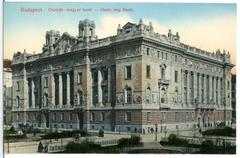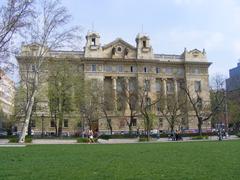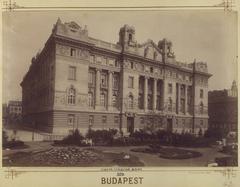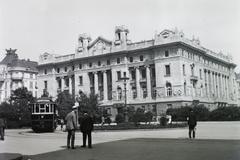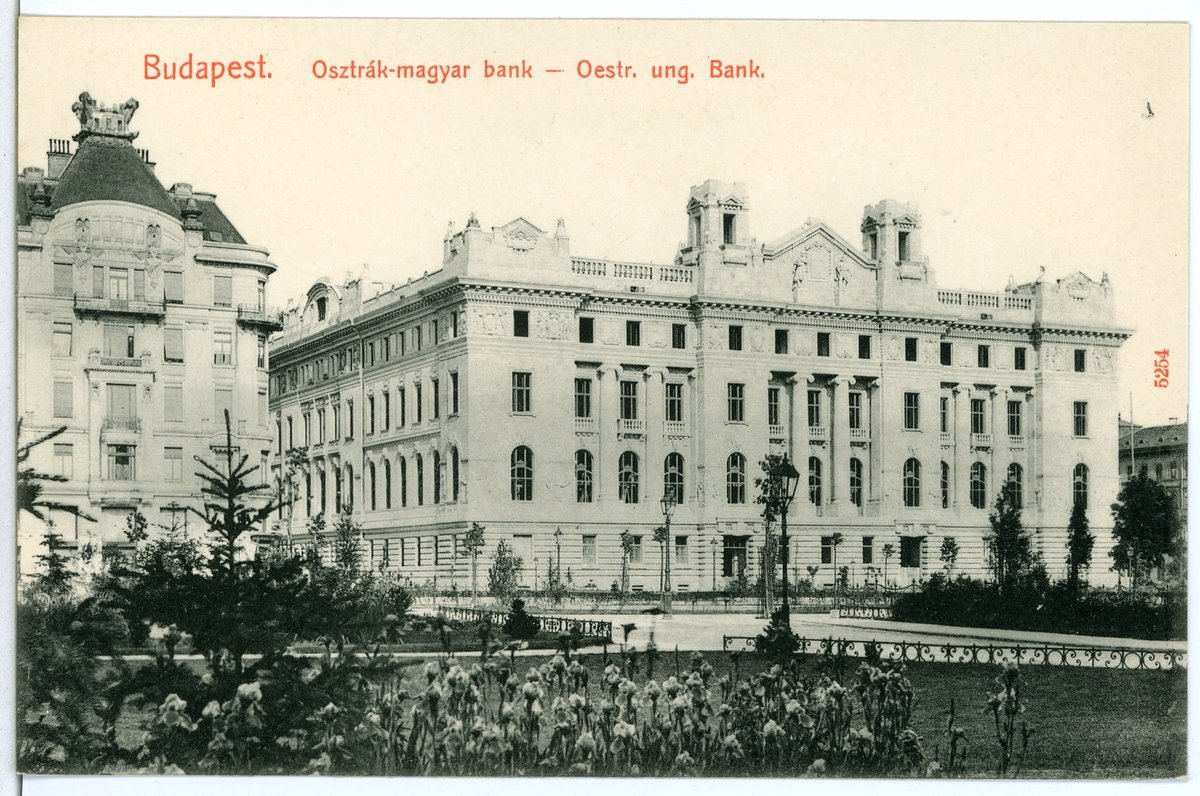
Hungarian National Bank Visiting Hours, Tickets, and Budapest Historical Sites Guide
Date: 14/06/2025
Introduction
The Hungarian National Bank (Magyar Nemzeti Bank, MNB) is not just the cornerstone of Hungary’s financial system—it is also an architectural gem and an essential historical landmark in Budapest. Situated on Szabadság (Liberty) Square, the Bank’s headquarters and the innovative Money Museum offer visitors an immersive journey through Hungary’s economic, political, and cultural evolution. This guide provides everything you need to plan your visit: MNB and Money Museum visiting hours, ticket information, accessibility, nearby attractions, and practical tips for a memorable experience.
Table of Contents
- Hungarian National Bank: History & Significance
- Architectural Highlights
- Role in Hungary’s Economic Development
- Visiting Hours, Tickets, and Accessibility
- Hungarian Money Museum: Exhibits & Experiences
- Nearby Attractions and Travel Tips
- Frequently Asked Questions (FAQ)
- Conclusion and Next Steps
- References
Hungarian National Bank: History & Significance
Founded in 1924 in the aftermath of World War I and the Treaty of Trianon, the Hungarian National Bank emerged as a symbol of Hungary’s restored monetary sovereignty (PestBuda). The Bank’s foundation marked a pivotal shift from the Austro-Hungarian banking system to an independent national institution, responsible for stabilizing the economy, introducing new currencies, and shaping financial policy through turbulent eras—including the interwar years, World War II, socialism, and post-communist transition (Original Berlin Tours; BudAPPest).
The central bank’s roles include issuing the Hungarian forint (HUF), setting monetary policy, managing reserves, and overseeing financial market infrastructure. Internationally, the MNB is integrated with the European System of Central Banks, the IMF, OECD, and BIS, reinforcing Hungary’s global economic standing (Wikipedia).
Architectural Highlights
The MNB headquarters, designed by Ignác Alpár and completed in 1905, exemplifies Budapest’s eclectic architectural tradition. The building blends late classical, baroque, and Renaissance styles, evident in its grand limestone façade and detailed reliefs depicting scenes of Hungary’s commercial past (PestBuda).
Key Features:
- Stained Glass Windows: Created by Miksa Róth, they add brilliance to the interior.
- Facade Reliefs: Sculpted by Károly Senyei, narrate the nation’s financial journey.
- Sculptural Ornamentation: The building’s artistic elements emphasize the importance of commerce and national prosperity.
The building has undergone several renovations, most notably recent efforts to restore its original grandeur while modernizing it for energy efficiency and accessibility (PestBuda).
Role in Hungary’s Economic Development
Interwar and WWII Periods: The MNB oversaw the introduction of the pengő and, later, the forint in response to hyperinflation after World War II (BudAPPest).
Socialist Era: The bank operated under state control, yet played a key role in economic reforms, especially during the New Economic Mechanism of 1968 (Rough Guides).
Modern Era: With the fall of communism, the MNB regained independence, adopting international standards and facilitating Hungary’s integration into global financial systems (BudAPPest).
Visiting Hours, Tickets, and Accessibility
Main Bank Building
- Public Access: Generally limited and subject to special guided tours or cultural events (e.g., Night of Museums).
- Visiting Hours: Variable—always check MNB’s official site or BookInBudapest for current schedules.
- Admission: Often free for exterior and public spaces; special exhibitions or tours may require tickets and advance booking.
Hungarian Money Museum and Visitor Centre
- Location: 1122 Budapest, Krisztina körút 6 (near Széll Kálmán tér).
- Opening Hours:
- Monday, Wednesday, Friday: 08:00–17:00
- Thursday: 08:00–19:00
- Saturday, Sunday: 10:00–18:00
- Closed on Tuesdays
(Money Museum ticket info)
- Admission: Free, but advance online registration is mandatory due to capacity limits.
- Guided Tours: Available upon request; must be booked in advance.
- Accessibility: Fully wheelchair accessible, with elevators, accessible restrooms, and clear signage (Money Museum accessibility).
- Facilities: Cloakroom, gift shop, café, panoramic terrace.
Hungarian Money Museum: Exhibits & Experiences
Opened in 2022, the Money Museum illustrates the history of currency and finance through interactive, multimedia displays (Money Museum overview).
Permanent Exhibition—“The Path of Money”:
- Traces currency from ancient barter to digital finance.
- Rare coins, historical banknotes, and artifacts.
Interactive Installations:
- Lift a Gold Bar: A genuine 12.5 kg gold bar from Hungary’s reserves.
- Personalized Banknote Printing: Create and print a custom souvenir banknote featuring your portrait.
- Financial Games & Simulations: Test your economic knowledge, explore monetary policy, and try investment simulations.
- Numismatic Workshops: Regular educational sessions for all ages.
Special Features:
- Panoramic Terrace: Offers sweeping city views.
- On-site Café: Stylish and open to all.
Booking:
All visits require a free, advance booking via the official site.
Nearby Attractions and Travel Tips
Location:
Szabadság Square is at the heart of Budapest, surrounded by:
- Hungarian Parliament (750 m)
- St. Stephen’s Basilica (400 m)
- House of Hungarian Art Nouveau (400 m)
- Gresham Palace
- Shoes on the Danube Memorial
Getting There:
- Public Transport: Near Kossuth Lajos tér (Metro Line 2) and Arany János utca (Metro Line 3). Trams, buses, and the Budapest Card make travel easy (Headout).
- Parking: Limited—public transport is recommended.
Amenities:
- Numerous cafés, restaurants, and shops nearby.
- Most exhibitions and tours offered in both Hungarian and English.
Practical Tips:
- Bring valid ID for entry.
- Photography is allowed outside; ask for permission indoors.
- Dress smart casual for tours/events.
- Spring and autumn offer pleasant weather and fewer crowds.
- For payments, carry Hungarian forints; ATMs and cards are widely accepted (33TravelTips).
Frequently Asked Questions (FAQ)
Q: What are the Hungarian National Bank visiting hours?
A: Hours vary; check the official MNB website or BookInBudapest.
Q: Is the Money Museum free?
A: Yes, admission is free, but advance online booking is required (Money Museum ticket info).
Q: Are guided tours available?
A: Yes, for both the Money Museum (with advance booking) and the main building during special events.
Q: Is the Bank accessible for visitors with disabilities?
A: The Money Museum is fully accessible; the main building has partial access—contact ahead for details.
Q: Can I take photos inside?
A: Allowed outside; inside, rules vary—ask staff before photographing.
Q: What else can I visit nearby?
A: Parliament, Basilica, art nouveau landmarks, and the Danube promenade.
Conclusion and Next Steps
Visiting the Hungarian National Bank and Money Museum is an enriching experience for anyone interested in history, architecture, or finance. The Bank’s legacy, coupled with the Money Museum’s interactive educational mission, offers a profound window into Hungary’s economic resilience and cultural identity.
Plan ahead:
- Check visiting hours and book your tickets online.
- Explore the vibrant surroundings of Szabadság Square.
- Enhance your trip with guided tours and the latest updates via the Audiala mobile app.
For a deeper dive into Budapest’s historical landscape, see our related guides on top museums, family-friendly attractions, and walking tours of the city.
References
- Hungarian National Bank Regains Its Original Splendour (PestBuda)
- The History and Stories of Budapest’s Liberty Square (Original Berlin Tours)
- Guide to Currency and Payments in Budapest for Foreign Tourists (BudAPPest)
- Hungarian Money Museum and Visitor Centre (Money Museum official)
- Visitor Centre Hungarian National Bank (BookInBudapest)
- Hungarian National Bank History (MNB official history)
- National Bank of Hungary (Wikipedia)
- Budapest Travel Tips
- Budapest Museums and Attractions

